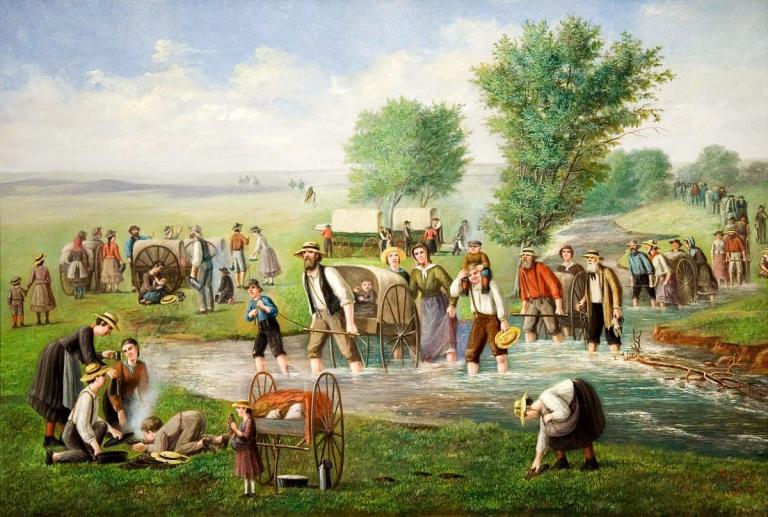
Hot off the metaphorical press, two articles have appeared today in Interpreter: A Journal of Latter-day Saint Faith and Scholarship:
Abstract: When researching and evaluating historical information, it is easy to come across things that may lead to a crisis of faith. Some of those crises may lead individuals to leave the Church and actively proselytize against it. It is much better when dealing with historical issues to approach them from a standpoint of charity, treating historical figures as we would like to be treated.
“I Don’t Have a Testimony of the History of the Church”
Abstract: In this masterful presentation, accomplished historian Davis Bitton addresses the role of history and belief. Testimonies, he asserts, are born of belief and spiritual witnesses, not from historical events. It is quite possible to know all about Church history and still remain a believing member.
***
I published the article below in the Deseret News, back on 2 February 2018:
Nearly a month ago, during the inaugural broadcast of the Interpreter Foundation’s weekly radio program (online at interpreterfoundation.org/the-interpreter-radio-show/), a caller reported that many in his circle were renouncing their faith. He sadly declared that, among his acquaintances, the church is suffering a “demographic meltdown.”
Whether there actually is such a “meltdown” would be an interesting (and important) topic for discussion, but my focus here is rather different: His own commitment to the gospel, the caller said, is purely emotional, a result of his personal autobiography. He chooses to remain a member of The Church of Jesus Christ of Latter-day Saints despite his conviction that, for every reason to believe in Mormonism, there are at least 20 reasons to reject it.
If my own faith were merely emotional, if I agreed that the reasons for abandoning the claims of the Restoration far outweigh those for accepting them, I probably would have left the church long ago myself. If those in his circle feel the same way, their response isn’t very surprising.
But this very newspaper column is a testimony that I don’t share his evaluation. In fact, my position is quite the contrary.
I don’t deny the existence of questions, even possible reasons for doubt. These definitely exist, and, I believe, they exist by divine intention.
If God were to reveal himself fully and with unmistakable, irresistible clarity, that revelation would overwhelm and destroy our freedom. In his “Philosophical Fragments” (1844), the Danish philosopher Soren Kierkegaard uses a parable about a king and a maiden to make this point: How can the king reveal his love to a woman of humble parentage — given the huge disparity of rank, status and wealth between them — without coercing and crushing her?
“Not to reveal oneself,” he writes, “is the death of love, to reveal oneself is the death of the beloved.” The only real choice open to the king is to court his beloved indirectly, by descending to her station, by taking on the character of a servant. So he disguises himself.
God, Kierkegaard says, wants us to love him freely because we come to know him as lovable, not because he’s powerful, terrifying or overwhelming. And we have abundant reason to do that.
In a similar way, though he wants us to develop faith or trust in him, he doesn’t seek a compelled belief. He doesn’t desire an assent that has been forced upon us because we had no rational alternative or escape.
Accordingly, for those with eyes to see and ears to hear, there are hints and clues. (Cosmic fine-tuning, for example, seems to suggest that a vastly powerful intelligence desired to foster life, but it doesn’t absolutely require that conclusion.) There are evidences and personal spiritual experiences, but no undeniable public proofs.
For eight years, I’ve published a column each week (now totaling over 400 mini-essays; for a list with links, see deseretnews.com/author/22746/Daniel-Peterson.html), almost invariably laying out one or more reasons to trust the claims of Christianity in general and those of the Restored Church in particular.
Moreover, many of these columns have suggested further reading. See, for example, “Some aids to nourish our faith” and my note on the fascinating research of Brian Stubbs, “Near Eastern languages in ancient America?”
To these book and article recommendations, I could add many more, including the important new volume “Knowing Why: 137 Evidences That the Book of Mormon Is True” . The classic products published by the Foundation for Ancient Research and Mormon Studies (known as FARMS) and, in its first years, by its successor organization, the Neal A. Maxwell Institute for Religious Scholarship, remain very powerful. I would perhaps suggest starting with volumes such as “Rediscovering the Book of Mormon” (1991), “Reexploring the Book of Mormon” (1992) and “Pressing Forward with the Book of Mormon” (1999).
Since 2012, the mission of FARMS and the original Maxwell Institute has largely been taken up by Book of Mormon Central, which is online at bookofmormoncentral.org, and the Interpreter Foundation, online at interpreterfoundation.org and of which I am the board chairman. Together, they offer a treasure trove of material representing decades of faithful scholarship, as well as the exciting recent work of such scholars as Matthew Bowen, Stanford Carmack and Royal Skousen (see mormoninterpreter.com/journal/all-papers/)).
Personal conviction comes in many ways. To share the gospel convincingly with others, however, we must follow the counsel of 1 Peter 3:15, to “be ready always to give an answer to every man that asketh you a reason of the hope that is in you.” Good, faith-sustaining reasons are readily available.











